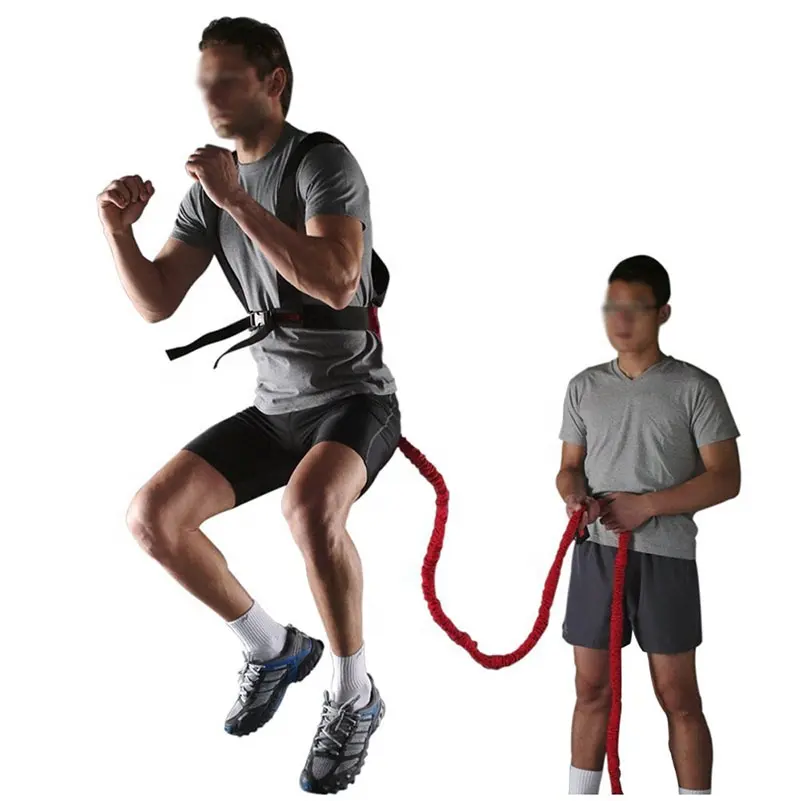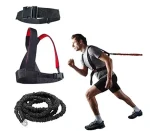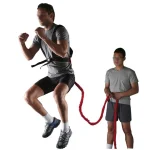

Back Ultra Resistance Rope
25 د.ا
- Made of the finest materials that suit various exercises
- Resistance rope that can be stretched for a long distance without breaking
- High quality fixing hook
- Suitable for all sports and is multi-exercise
- The picture and video are identical to the product
- Back Ultra resistance rope
- resistance band
| العلامة التجارية |
World Fitness |
|---|---|
| اللون |
اسود |
| بلد المنشأ |
Back Ultra Resistance Band
resistance band
The original Back Ultra resistance band set provides a comprehensive and versatile workout experience to enhance fitness and build strength. It increases muscle strength, slims and tightens the entire body and is suitable for all sports that help improve muscle strength and endurance. This set allows users to perform different exercises for different parts of the body.
Features
High durability: Made of high-quality materials that provide durability and strong endurance for strenuous exercises.
Easy storage: The set comes with a convenient storage bag, making it easy to carry and store.
Variety of exercises: Allows you to perform strength, flexibility and endurance exercises, which helps achieve fitness goals effectively.
Enjoy a comprehensive and effective workout experience with the 5-piece fitness resistance band set to improve your fitness in a flexible and fun way.
Benefits of resistance exercises
Increase muscle strength and tension, which helps protect joints from injuries.
Maintain body flexibility and balance, which helps maintain body health as you age.
Controlling weight and increasing the ratio of muscle to fat, which increases the burning of calories, as muscles consume more calories than fat.
It may help reduce or prevent mental deterioration in the elderly.
Increasing endurance, as the stronger the body’s muscles, the less quickly a person feels tired after performing various activities.
Preventing or controlling some chronic diseases such as diabetes, heart disease, arthritis, back pain, obesity, and depression.
Improving the ability to move and balance.
Improving the appearance and posture of the body.
Reducing the risk of injuries.
Improving bone strength and density, and reducing the risk of osteoporosis.
Improving the feeling of health, increasing self-confidence, and improving mood.
Improving sleep quality, and preventing insomnia.
Increasing self-esteem.
Improving the efficiency of performing daily activities.
Read also: Health benefits of exercise
How do resistance exercises affect the body?
Resistance exercises cause microscopic (very small) damage or tears to muscle cells, which the body quickly repairs to help the muscles recover and increase their strength.
Muscle fibers undergo a catabolism process during exercise, which is met by a building process (anabolism) of muscle tissue afterwards, where a number of compounds such as testosterone, insulin-like growth factor, growth hormone, proteins, and nutrients flow into the muscles to repair them and make them stronger, during the recovery period, which is a period during which the muscles should not be stressed.
Basic principles of resistance exercises
Resistance exercises include a number of principles or elements, the basic principles of which include the following:
The sports system, where the sports system or program for resistance exercises includes different types of exercises, such as aerobic training, flexibility exercises, strength exercises, and balance exercises.
Weights or weights, where different weights are used, in various forms such as hand weights, rubber bands, body weight, and others, to provide resistance and resistance to perform various strength exercises.
Exercises, where specific exercises are performed specifically designed to strengthen specific muscles, or a group of muscles.
Repetition, which refers to the number of times the exercises are repeated continuously.
Set, which is the set of repetitions that are performed without a break for a specific exercise, as doing two sets of 20 repetitions, for example, means repeating a specific exercise 20 times without a break, then taking a break, then performing the same exercise 20 times again without a break.
Rest, where a break must be taken between sets, and the duration of this rest depends on the intensity of the exercise that was performed.
Diversity, which includes making changes to the training routine, such as performing new exercises, challenging the muscles and forcing them to adapt to the exercises and strengthen them.
Gradual increase in load, as continuing to benefit from resistance exercises requires doing the exercises to the point where it becomes difficult to do any other repetition of these exercises, by using weights or appropriate resistance and resistance force, while maintaining the appropriate techniques for doing the exercises, and making the necessary adjustments periodically to the intensity of the exercises, their duration, and the specific exercises for each muscle group, their number, sets and repetitions, which helps to obtain the best results.
Recovery, the muscles need some time to recover and adapt after performing the exercises, as it is recommended to rest the muscle group that was trained for 48 hours before training it again.
Read also: Flexibility and elasticity exercises
Types of resistance exercises
Exercise using body weight
You can use your body weight to perform resistance exercises, such as push-ups, pull-ups, squats, and sit-ups, etc., which can be done almost anywhere without the need for special equipment. Although it is not possible to change your body weight to control the degree of resistance, there are a number of techniques that help control this, which you can consult a specialist trainer about.
Exercise using free weights
Free weights, or iron weights (in English: Dumbbells and Barbells), can be used to perform many different exercises for the various muscles of the body, which, unlike training devices that restrict body movement, allow you to perform exercises according to the body structure. They also help improve the coordination and balance of the body, as they require skill in moving and controlling weights, which also helps to employ and train muscles other than the muscles targeted by the exercise itself.
Despite the advantages of this method, caution should be exercised against the risk of injuries that may result from falling iron weights, and they may require a large space to store if their number increases, in addition to the fact that they require skill and knowledge to perform their exercises in the best way, so it is recommended to obtain the help of a specialized trainer for beginners.
Exercise using training devices
Training devices are easy to use, as the amount of weight and resistance required can be easily controlled, and they are safe, and do not require a lot of skill and body coordination.
Despite the advantages of these devices, these devices are expensive, and require large spaces to store them, and most of these devices, with the exception of the cable pulley machines, focus on a specific group of muscles, which requires the use of many devices to train the various muscles of the body, and they may cause some injuries to the joints with repeated use, if the body structure does not match the nature of the device’s movement.
Exercise with training belts
Training belts or tubes consist of elastic bands with handles that can be used as an alternative to free weights or training devices to perform resistance exercises, and are available in different thicknesses, each of which provides a different amount of resistance.
Training belts are characterized by being inexpensive, and that they have various shapes and uses, and many exercises can be performed using them, and the possibility of transporting them and using them in different places, in addition to the ease of storing them, but they may lose some of their flexibility with repeated use, and may be exposed to tearing if they rub against a sharp surface.
Some of the tools that can be used in resistance exercises also include training balls, sandbags, and suspension devices that rely on body weight and gravity to perform different forms of exercises.
None of the previous exercise methods is better than others, as long as the muscles contract against the effect of external resistance or resistance, this helps to strengthen them and improve their muscle tension.
Starting resistance exercises
It is recommended to do what is known as a pre-exercise screening before starting resistance exercises, which is a test used to identify people who suffer from health problems that may put them at risk while exercising, which is discussed with a doctor or a specialized trainer.
It is recommended to seek the help of a specialized trainer to develop a sports program suitable for beginners, while making sure to warm up before starting resistance exercises, such as walking, or cycling for 5 minutes, with some stretching exercises.
The traditional resistance exercise program for beginners includes the following:
Start with 8-10 exercises that train the main muscles of the body, and are performed 2-3 times a week.
Perform one set for each exercise, so that the set consists of 8 repetitions, provided that it does not exceed twice a week in the beginning.
Gradually increase the number of sets to 2-3 sets, with each set consisting of 8-12 repetitions, repeated every two or three days, then increase the intensity of the exercises after reaching a stage where the person can easily complete 12 repetitions of the exercise.
Read also: Warm-up exercises
Resistance exercises for heart or stroke patients
Some people may think that exercising after a heart attack or stroke may cause them harm, but in fact exercising regularly reduces the chances of having another stroke, and exercise improves the functions of the circulatory system, the ability to walk, and the strength of the arms, so doctors advise stroke patients to exercise.
Before starting any type of exercise, you should consult a doctor to make sure that it is effective and harmless.
Myths about resistance exercises
There are a number of myths or misinformation about resistance exercises that may prevent some people from practicing them and enjoying their many health benefits. These mistakes include:
Resistance exercises cause the body to become bulky, which prevents many women from practicing these exercises, but in fact resistance exercises do not cause the body to become bulky in most women, but they make the muscles more prominent, in addition to tightening the muscles and making them look sculpted, and the prominence of the muscles depends on the amount of fat covering them.
Resistance exercises cause weight gain, resistance exercises may cause a slight increase in weight, as muscle mass weighs more than fat masses, but although body weight may increase, body size may decrease, and muscles help maintain healthy metabolic processes (metabolism), and burn a greater number of calories compared to fat.
Resistance exercises require going to gyms, this idea is considered one of the most misconceptions about resistance exercises among people, as one of the best forms of resistance exercises are exercises that rely mainly on body weight, without the need to use any additional weights, and without the need to join gyms.








 Handball supplies
Handball supplies

















